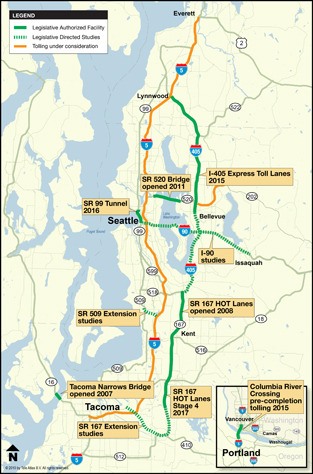Rep. Judy Clibborn wants Islanders to know that she is on their side. She sat down with the Reporter on a Sunday afternoon to respond to statements made about her role in determining the use of I-90 tolls to pay for SR-520. Clibborn is the chair of the House Transportation Committee of the Washington state Legislature.
There is an oft-quoted statement by Clibborn, who said in 2009, that “tolling was off the table for Mercer Island.” That statement was made Clibborn said, in regards to the use of funds to repay the bonds that were purchased in 2009 for SR-520, and only in an emergency “if all other sources were insufficient to repay the bonds.”
Did you go ‘back on your word’ when you said that tolling would not be considered for I-90?
Clibborn does not deny that she said Islanders would object to pay for a bridge that they did not use, but she said it was a “situational comment regarding the need to solidify funding for the (SR-520) bridge.”
“Having to toll I-90 was considered a last resort,” she explained. “The belief was that it was something that would not be needed.”
In order to sell bonds for the amount needed to rebuild the bridge, the Legislature had to secure the bonds with three different revenue streams, she said. The bridge was to be funded primarily by gas tax revenues, some government and federal sources and from the sale of bonds.
The last of those sources was to be tolling I-90 if the funds from those sources was not adequate.
But now, some four years later, everything is gone except the gas tax, she said. There is very little, if any, federal dollars for these roads.
Why is just I-90 being considered for tolling? What about I-5 or even I-405?
Clibborn wants people to understand that tolling regionwide is coming. “These plans have been in the works for some time,” she said.
The Legislature has authorized tolling for all of I-405 from Lynnwood south to the SR-167 extension. Tolls on I-5 are under consideration. Tolls for the SR-99 tunnel under Seattle are also authorized. The Columbia River bridge is also to be tolled.
What about tolling the western access to the SR-520 bridge in Montlake? Why isn’t that being considered?
As for tolling the approach to Montlake, Clibborn said she was not sure how much more money that would collect and that the approach is not really considered a part of the bridge. However, she said that, too, could be considered in an EIS as an option or additional source of funding.
“All of these items can be considered in the EIS,” she said. “You ask the questions. And those questions help determine how the impact of tolling can be mitigated.”
Why wasn’t there any money in the $10 billiontransportation package proposed for the session?
“My job is to provide funding for transportation statewide,” she said. There is a long list of projects that are unfunded and roadways in need of repair.
Of the statewide transportation funding package before the Legislature, Clibborn said it has been already whittled down substantially. “It is not $10 billion any longer,” she said.
Again, she said, everything else is gone except the gas tax, and possibly weight fees for trucks.
Is it possible that a full EIS will not be done?
“I cannot imagine that they (WSDOT) would not want to do an EIS,” she said.
In fact, she said, money has already be requested for the full study in the upcoming budget.
Also, the DOT is asking for input on the idea of fairness or social justice, she said. “They want to know if it is unfair and too burdensome.”
The full EIS will give everyone, including Islanders and others, time to have their questions asked and their concerns answered. Once the EIS process is begun, then “Islanders can make their case.”
What should Islanders consider as this process goes forward?
Clibborn urges Islanders to continue to participate in the EA and EIS process.
What she hopes Islanders will remember is that there will be different tolls for different times of day. That tolling and how it is finally implemented will take time — maybe years.
“We can prolong or delay it,” she said of tolling, “but we cannot stop it.”
A summary of the open houses and comments regarding tolling gathered from meetings and online was published on Feb. 20 by WSDOT at www.psrc.org/assets/9315/I-90TollingSNTC20130220.pdf.
How do tolls on I-90 and SR-520 decades ago compare to now:
Here’s a slightly revised version of what it used to cost to make a round trip across Lake Washington in today’s dollars.
• From 1963 to 1979 on SR-520, the original toll was $0.35 (each way)
• $0.70 round trip toll in 1963 = $5.35 in 2012
( Books of 20 tickets were sold for $3.90, bringing the effective toll to $2.91.)
• From 1940 to 1949, the original (U.S. Highway 10) I-90 toll was $0.25 (each way)
• $0.50 round trip toll in 1940 = $8.17 in 2012
Source: Federal Reserve Bank of Minneapolis CPI calculator, www.minneapolisfed.org.


